Author(s): Mbah C A*, Anibeze C I P, Ndukwe G U, Ovie F O, Didigwu C A and Obi K C
Piper guineense (Uziza in Igbo) is a medicinal plant whose leaves are commonly used as spices.This study is to investigate the effects of the ethanolic leaf extracts of P.guineenseon the histology of the liver, liver biomarker enzymes of paraquat-induced Thirty (30) adult male Wistar rats weighing between 160g – 200g which was randomly assigned to six Groups (A-F) of 5 rats each. The control Group A was not induced with paraquat, while Groups B, D, E and F were induced with 20mg/kg of paraquat. Group C received 200mg/kg of the extract only. After the fourteenth day, groups E and F were withdrawn and treated with 80mg/kg and 100mg/kg of the extract, respectively, for another fourteen days; while Group D was withdrawn without treatment.The results showed that animals in all Groups (P<0.05) except B (-21.67 ± 22.55) and D (-12.21 ± 15.67) had decreased in body weight; severely degenerated hepatic tissue with severe aggregates of intra lobular inflammatory cells, sever intra hepatic haemorrhage and necrotic debris around the haemorrhagic area; These effects were ameliorated in Groups E and F which received the variable doses of the ethanolic leaf extracts of P.guineense. The ethanolic leaf extracts of P.guineense have ameliorative effects on the body weight, serum levels of ALT, AST, ALP, and histologic changes in liver and testes of paraquat-induced Wistar rats.
The use of spices in culinary predates recorded history and is said to have been an integral part of local dishes in South Asia and the Middle East as far back as 2000 BCE [1]. Spices are functional foods; these are foods that can be demonstrated to have a beneficial effect on certain target functions in the body beyond basic nutritional requirements [2]. Spices occur in a variety of flavor, color, and aroma contributing a wide range of nutrients to foods [3]. They enhance and complement flavor in foods with no detrimental effect on the organoleptic quality of the food [4].
One of such plants used as a local spice in Nigeria is Uziza (Piper guineense) which is from the family Piperaceae and from genus. It is a West African spice plant commonly called Ashanti pepper (Ramadori, 2008). It is known as Uziza in Igbo and Iyere in Yoruba. Other common names are Benin pepper, Guinea pepper and false cubeb (Ramadori, 2008). Uziza leave consist of rhizomes, bulbs, flower bud, fruit, seed, and leaves. They are categorized into tiny wild fruits, nuts, herbs, and leafy vegetables spine (Ramadori, 2008). The plants that provide Ashanti pepper are vines that grow up to 20m tall climbing up bole of trees by means of adventitious roots. It is a perennial plant that is characterized by heart-shaped leaves and oval, petiole, alternate, 12cm long. The leaf which have a peppery taste, are pale greenish color when fresh and darker green when frozen or dried. Flowers are greenish yellow and arranged in a spiral along the spine (Ramadori, 2008). The fruits of Uziza (Piper guineense) occur in clusters, small, reddish or reddish brown when ripe and black when dry [5].
Paraquat is not only toxic to plants but adversely affect humans and farm animals by accumulating in the lungs, liver, kidneys and heart [6]. Animal exposure occurs by accidental or intentional swallowing or through contact with damaged skin or inhalation [7]. Studies on paraquat have shown that chronic exposure can lead to lung and liver damage, kidney failure and parkinsonian lesions in additions to fibrosis [7]. Paraquat toxicity occurs through excess production of free radicals which result in oxidative stress and damage [8].
The uziza(Piper guineense) is a medicinal plant that has wide application in African traditional medicine. Basically, in this modern age, people add it to soups to boost the nutrient and aroma. Some of its medicinal benefits of uziza leaf are; Anti fungi, antibacterial, antioxidant, anticancer and anti-inflammatory effects [9]. Other benefits include Lowering of Ulcer Risk, good for fertility, Cough and Intestinal Diseases. Also, another study reported that results obtained showed that P. guineense fruit and leaf extracts have activity against human pathogenic bacterial and fungal strains [9]. An assessment of the effect of Uziza (Piper guineense) consumption on various human organs is essential to ascertain merits and detect demerits if any in order to avert health conditions that may arise overtime due to continual use [10]. And also the seeds of Uziza (Piper guineense) are also recommended for anti-inflammatory purposes [10].
The organs of interest, the Liver; which is the largest compound organ weighing 1.5kg in adult humans [11, 12]. It lies in the right upper quadrant of the abdomen and is completely protected by the thoracic rib cage. The liver is the principal metabolic organ and massive detoxification center for alcohol, drugs and other chemical substances, thus is directly influenced overtime by the nutritional benefits of substances assimilated [13,14].
The function of the liver as a detoxifying and clearance organ harbors the danger that the substances that should be degraded and/ or eliminated eventually lead to tissue damage .
Thirty (30) male adult albino wister rats weighing of 160g - 200g were gotten from Amaka animals farm in Abia state university, Abia state. The rats were housed in Wire gauze cages and allowed to acclimatize in the animal house of the department of anatomy, Abia State University Uturu campus, Abia state for the period of one week before exposure. The rats were feed with rat chow and were provided with water ad libitum throughout the duration of the experiment.Randomly assigned to six Groups (A-F) (n- 5). The control Group A was not induced with paraquat, while Groups B, D, E and F were induced with 20mg/kg of paraquat. Group C received 200mg/kg of the extract only. After the fourteenth day, groups E and F were withdrawn and treated with 80mg/kg and 100mg/kg of the extract, respectively, for another fourteen days; while Group D was withdrawn without treatment and the animals were sacrificed at the end of the experiment of day 22. Blood was gotten from the animals via ocular puncture, and it was used for hormonal assey of the liver, and immediately the animals were sacrified and the liver was measured immediately the animals was sacrified and and fix in a 10% normal saline which is used for the histology.
Raw data obtained such as body weights, relative organ weights and hormonal results were analyzed using the SPSS (version 21) software package. All the results obtained were expressed as Mean value ± SEM (Standard error of mean) in each group. All the tested parameters were subjected to statistical analysis using Paired T-test and the one-way analysis of Variance (ANOVA). Differences between means were regarded significant at P<0.05.
This research was sought and obtained from the Chairman Ethical Committee in the Anatomy Department, Faculty of Basic Medical Sciences, Abia State University, Uturu Campus. The experimental procedures of this Study complied with ARRIVE guidelines, National Institutes of Health (NIH) guidelines, and National Health Research Ethics Laboratory Animals.
The effect of Ethanolic Extract of Uziza (Piper Guineense) and Paraquat on Body Weight of adult male wistar rats.
| S/N | Group | Initial Body Weight (g) Mean ± SEM |
Final Body Weight (g) Mean ± SEM |
p-value | T-test |
|---|---|---|---|---|---|
| 1 | A | 162.50 ± 17.68 | 217.50 ± 10.61 | 0.058 | -11.00 |
| 2 | B | 169.34 ± 14.43 | 147.67 ± 11.65 | 0.128 | 1.664 |
| 3 | C | 167.67 ± 2.89 | 229.61 ± 14.43 | 0.057 | -4.000 |
| 4 | D | 168.33 ± 7.64 | 156.12 ± 15.13 | 0.044* | 4.619 |
| 5 | E | 167.67 ± 2.89 | 208.33 ± 14.73 | 0.076 | -3.413 |
| 6 | F | 185.00 ± 13.23 | 225.00 ± 25.00 | 0.057 | -4.000 |
*p < 0.05 when comparing with group A (control)
Table 1: shows the analysis of the body weight showed that there was a significant decrease in weight difference in group B and group D compared with group A. There was however insignificant increase in other groups when compared with group A Date were analyzed using Paired T-test and the one-way analysis of Variance (ANOVA), followed by Post HOC Bonferroni’s multiple Comparison Values were expressed as mean ± SEM (Standard error of mean) and were considered significant at *p < 0.05. Group A served as control and received only distilled water and was not induced with paraquat, while Groups B, D, E and F were induced with 20mg/kg of paraquat. Group C received 200mg/kg of the extract only. After the fourteenth day, groups E and F were withdrawn and treated with 80mg/kg and 100mg/kg of the extract, respectively, for another fourteen days; while Group D was withdrawn without treatment.
Effect of Ethanolic extract of Uziza (Piper Guineense) and paraquat on Serum Aspartate Transaminase (AST), Alanine Transaminase (ALT) and Alanine Phosphatase (ALP) of adult male wistar rats. Table 2: mean values of AST, ALT and ALP obtained at the end of the experiment
| S/N | Group | AST (IU/L) ± S.E.M | ALT (IU/L) ± S.E.M | ALP (IU/L) ± S.E.M |
|---|---|---|---|---|
| 1 | A | 184.31± 14.67 | 95.22± 4.45 | 134.72± 15.58 |
| 2 | B | 555.00± 46.40* | 262.13± 39.78* | 721.59± 32.28* |
| 3 | C | 185.42 ± 24.17 | 89.47 ± 13.45 | 140.15± 14.52 |
| 4 | D | 509.44± 0.36* | 236.00± 34.03* | 701.72± 18.86* |
| 5 | E | 430.28 ± 29.19* | 194.47 ± 12.41* | 393.25± 28.44* |
| 6 | F | 336.80 ± 26.51* | 139.47 ± 19.47* | 279.00± 69.21* |
*=p<0.05 when compared with group A (control)
Table 2: shows that there was a significantly higher level of AST, ALT and ALP in groups (B, D, E, and F) when compared with the control group A. There was however, an significant decrease in AST, ALT and ALP in group C
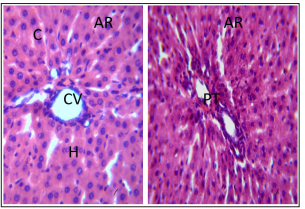
Control (x400) Plate 7 (x400)
Plate 1: showsphotomicrograph of control sections of liver of animals that received only water and food showing normal hepatic architecture with well perfused cytoplasm (C), hepatocyte(H), portal traid (PT) and central vein (CV) well represented in the
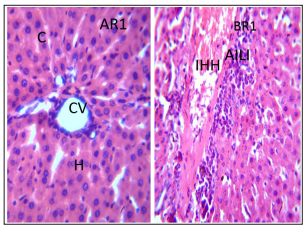
Plate 2: liver of group B that received (20mg of Paraquat) only which served as negative control
Photomicrograph of group B section of liver administered shows severe degeneration of the hepatic tissue with severe aggregate of intra lobular inflammatory cells (AILI) ,necrotic debris arround the hemorrhagic area and sever intra hepatic hemorrhage (IIH)
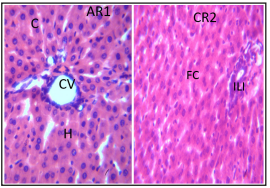
Control (x400) Plate 9B (x400)
Plate 3: Liver of Group C that received 200mg of Uziza (Piper guineense) once daily for 28 days.
Photomicrograph of group C section of liver administered shows mild fatty change(MFC) and mild intra lobular inflammation (ILI) otherwise normal.
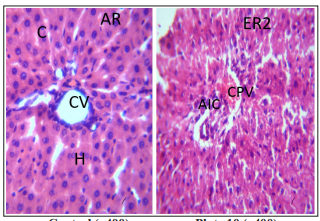
Control (x400) Plate 10 (x400)
Plate 4: Testes of Group D that received 20mg of Paraquatfor 14 daysafter which paraquat withdraw and rats feed with water and normal feed ad libitum till day 28
Photomicrograph of group D section of liver shows mild regeneration with moderate congestion of the central Vein (CCV) and aggregate of inflammation cell (AIC).
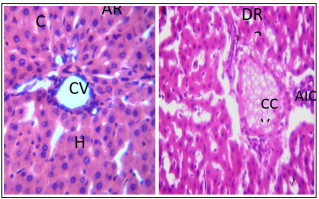
Control (x400) Plate 11 (x400)
Plate 5: Liver of Group E that received 20mg/kg of Paraquat for 14 days after which paraquat withdraw and rats feed with 80mg/ kg of ethanolic leaf extract of Uziza (Piper guineense) once daily till day 28
Photomicrograph of group E section of shows mild to moderate healing of with mild congestion of the portal Vein (CPV) and moderate intra hepatic aggregate of inflammatory cell (AIC)

Control (x400) Plate 12 (x400)
Plate 6: Liver of Group E that received 20mg of Paraquat and 100mg of Piperguineense (uziza plant extract)
Photomicrograph of group F section of liver shows moderate healing with portal aggregate of inflammatory cells (PAIC) and mild congestion (C).
Piper Guineense popularly known as Uziza is an important source of various nutrients and phytochemicals with diverse functions; it is a good medicinal plant that should always be included in our daily diet, so as to ensure the derivation of an adequate amount of the needed vitamins, phytochemicals and other nutrients present in the plant. The present study has shown that the leaves and seeds of uziza (Piper Guineense) contain appreciable amount of valuable nutrients. The leaves and seeds of uziza (Piper Guineense) can be used favourably having been found to contain important compounds needed for both the food and pharmaceutical industries as well as of great use in traditional medicine too. Much of the traditional uses has to be confirmed by scientific researchers. A lot of work has been done on the plant to determine its chemical constituents and biological activity, but more work is still needed to exploit their therapeutic utility in the management of diseases
Result from this study of the effect of Ethanolic extract of Uziza (Piper guineense) on body weight revealed that all groups showed increases in body weight with the exception of Group D which received 20mg/kg of paraquat. Group D showed a significant decrease when compared with Group A that served as the control. The reason for the increase in group A may be physiological due to the high fibre and carbohydrate content in the rat feed given to the control group. The reason for the increase in Groups B, C, E and F may be physiological too due to the high fibre and carbohydrate content in the rat feed in addition to the alligator pepper extract which is also rich in high fibre. This is in agreement with the findings of Ezejindu et al, [11]. In his research, there was body weight gain in the experimental groups that received Uziza (Piper guineense) when compared to the control group. The reason for the weight loss in group D might be due to the effect of paraquat being able to cause cell death by free radicals induced by Nicotinamide Adenine Dinucleotide Phosphate (NADPH) depletion [11].
From this study, the researcher concluded that:
This study also recommends that male farmers or agriculturists and avoid accidental ingestion of herbicides such as paraquat by their children or family members because it shares resemblance with (Hibiscus Sobdariffa) Zobo juice which have proven to be deleterious to health. More researches should also be carried out to ascertain the biochemical mechanism behind this healing property on liver damage.
